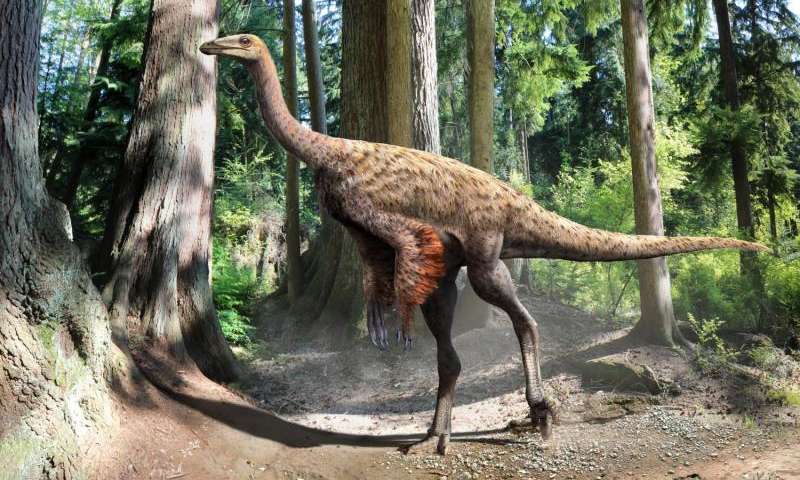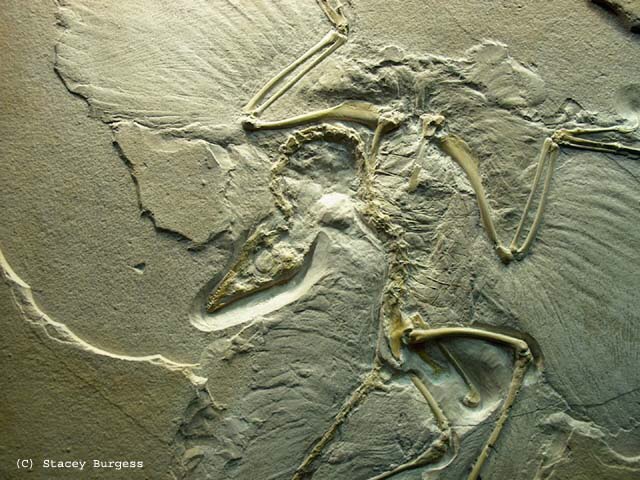It looks like you're using an Ad Blocker.
Please white-list or disable AboveTopSecret.com in your ad-blocking tool.
Thank you.
Some features of ATS will be disabled while you continue to use an ad-blocker.
share:
An undergraduate University of Alberta paleontology student has discovered an Ornithomimus dinosaur with preserved tail feathers and soft tissue. The discovery is shedding light on the convergent evolution of these dinosaurs with ostriches and emus relating to thermoregulation and is also tightening the linkages between dinosaurs and modern birds.
Ornithomimus dinosaur with preserved tail feathers and skin tightens linkages between dinosaurs and birds

This is interesting because I always hear that birds are descendants of dinosaurs and some artists depict dinosaurs as feathered. But here is an example where a dinosaur was found fossilized with its feathers intact! Apparently there are three specimens like this of the Ornithomimus in the world. Some people have said that birds and dinosaurs are not related, but this goes to show there is evidence that they are wrong.
This dinosaur is possibly related to the ostrich or emu. It was covered with feathers all over its body and had wings that it did not use to fly, but used for purposes such as mating.
edit on 04pmWed, 04 Nov 2015 14:03:10 -0600kbpmkAmerica/Chicago by darkbake because: (no reason
given)
edit on 04pmWed, 04 Nov 2015 14:04:41 -0600kbpmkAmerica/Chicago by darkbake because: (no reason given)
Go on Orni with your bad self and shake them tail feathers!
I'm shaking mine.
I'm shaking mine.
edit on 4-11-2015 by Rosinitiate because: (no reason given)
I thought they found the link between dinosaurs and birds years ago? Or is this just another confirmation of that? Also remember the experiments
done on chicken eggs. Experimenting with the genetics of it to give it teeth, long tail and generally look more dinosaur like.
a reply to: TerryDon79
I think this is just another confirmation of that, although this is the first time I have heard of a feathered dinosaur fossil being found, they have apparently been found in the past. I had always thought that they had not found any of them before until I read this article.
I think this is just another confirmation of that, although this is the first time I have heard of a feathered dinosaur fossil being found, they have apparently been found in the past. I had always thought that they had not found any of them before until I read this article.
edit on 04pmWed,
04 Nov 2015 14:06:24 -0600kbpmkAmerica/Chicago by darkbake because: (no reason given)
What are the chances of bird feathers being near what we are calling a dinosaur?
That never seems to make It into the deciding factors when identifying a feathered dino.
That never seems to make It into the deciding factors when identifying a feathered dino.
originally posted by: darkbake
a reply to: TerryDon79
I think this is just another confirmation of that, although this is the first time I have heard of a feathered dinosaur fossil being found, they have apparently been found in the past. I had always thought that they had not found any of them before until I read this article.
I think that had a fossil of an Archaeopteryx
Here you go:

Strange, I don't see the pic I posted.
edit on 4-11-2015 by Rosinitiate because: (no reason given)
My ex-girlfriend likes to wear feathers in her hair, for the sake of future evolutionists everywhere... I sure hope she doesn't fall into a tar pit.
originally posted by: Bone75
My ex-girlfriend likes to wear feathers in her hair, for the sake of future evolutionists everywhere... I sure hope she doesn't fall into a tar pit.
When i used to refer to my ex gf as THE BIRD she would say so do i peck for worms then
Start throwing old shoe laces at her
a reply to: Bone75
For the sake of humanity, I hope you do!
"Evolutionists"?
Really?
Anyway, there is plenty of evidence for feathered dinosaurs:
Melanosome evolution indicates a key physiological shift within feathered dinosaurs
A Jurassic ornithischian dinosaur from Siberia with both feathers and scales
Dinosaur Evolution: Feathers Up for Selection
Dinosaur color vision and the evolution of feathers
Google Scholar is a great resource for cutting out most of the Creationist chaff and getting to the real Science.
I recommend using it if you are tired of having to manually remove god-bothering pseudoscience.
For the sake of humanity, I hope you do!
"Evolutionists"?
Really?
Anyway, there is plenty of evidence for feathered dinosaurs:
Melanosome evolution indicates a key physiological shift within feathered dinosaurs
We find that in the lineage leading to birds, the observed increase in the diversity of melanosome morphologies appears abruptly, near the origin of pinnate feathers in maniraptoran dinosaurs. Similarly, mammals show an increased diversity of melanosome form compared to all ectothermic amniotes. In these two clades, mammals and maniraptoran dinosaurs including birds, melanosome form and colour are linked and colour reconstruction may be possible. By contrast, melanosomes in lizard, turtle and crocodilian skin, as well as the archosaurian filamentous body coverings (dinosaur ‘protofeathers’ and pterosaur ‘pycnofibres’), show a limited diversity of form that is uncorrelated with colour in extant taxa.
A Jurassic ornithischian dinosaur from Siberia with both feathers and scales
Middle Jurassic to Early Cretaceous deposits from northeastern China have yielded varied theropod dinosaurs bearing feathers. Filamentous integumentary structures have also been described in ornithischian dinosaurs, but whether these filaments can be regarded as part of the evolutionary lineage toward feathers remains controversial. Here we describe a new basal neornithischian dinosaur from the Jurassic of Siberia with small scales around the distal hindlimb, larger imbricated scales around the tail, monofilaments around the head and the thorax, and more complex featherlike structures around the humerus, the femur, and the tibia. The discovery of these branched integumentary structures outside theropods suggests that featherlike structures coexisted with scales and were potentially widespread among the entire dinosaur clade; feathers may thus have been present in the earliest dinosaurs.
Dinosaur Evolution: Feathers Up for Selection
After nearly one and half century of study and debate on whether extant birds are descendants of dinosaurs, paleontologists now generally agree that all birds are derived from a group of small-sized theropods (a suborder of bipedal saurischian or ‘lizard-hipped’ dinosaurs). In the past two decades, paleontology has also made remarkable progress in understanding of the origin and early evolution of bird feathers. Since the first report of proto-feathers from the theropod dinosaur Sinosauropteryx [1], diverse types of feathers in dinosaurs, including theropods and ornithischians, (one of the two basic divisions of dinosaurs, the ‘bird-hipped’ dinosaurs) have been reported mainly from the Early Cretaceous (about 120 million years ago) but also Middle-Late Jurassic (about 160 million years ago) deposits in northeastern China that have tremendously improved our understanding of the evolutionary transition from dinosaur to bird
Dinosaur color vision and the evolution of feathers
The first feathers that evolved in early dinosaurs had a simple hairlike structure and probably served to insulate the body. How did these simple protofeathers evolve into the more complex feathers found in today's birds? In a Perspective, Koschowitz et al. argue that dinosaur color vision played a key role in this evolution. Dinosaur color vision, like that of birds, is likely to have been superior to that of humans. The evolution of complex feathers would have enabled color signaling; for example, during sexual selection.
Google Scholar is a great resource for cutting out most of the Creationist chaff and getting to the real Science.
I recommend using it if you are tired of having to manually remove god-bothering pseudoscience.
a reply to: deadeyedick
Paleontologists can compare the bone structure of the dinosaurs in question with other dinosaurs in order to find out which they are related to and how. There is science behind it - if they weren't dinosaur bones they were dealing with, they would know.
Paleontologists can compare the bone structure of the dinosaurs in question with other dinosaurs in order to find out which they are related to and how. There is science behind it - if they weren't dinosaur bones they were dealing with, they would know.
originally posted by: Bone75
originally posted by: aorAki
a reply to: Bone75
For the sake of humanity, I hope you do!
But then they would think they discovered a new species due to my freakishly large penis. do i pck for worms then o never mind
That is what i wanted to say in my last post but the t&c her might choke you
new topics
-
Sorry to disappoint you but...
US Political Madness: 1 hours ago -
Watch as a 12 million years old Crab Emerges from a Rock
Ancient & Lost Civilizations: 6 hours ago
top topics
-
Speaking of Pandemics
General Conspiracies: 15 hours ago, 9 flags -
ILLUMINATION: Dimensions / Degrees – Da Vincis Last Supper And The Philosophers Stone
Secret Societies: 12 hours ago, 9 flags -
Watch as a 12 million years old Crab Emerges from a Rock
Ancient & Lost Civilizations: 6 hours ago, 9 flags -
Just Sick of It! Done! Can't take it anymore!
General Chit Chat: 13 hours ago, 8 flags -
Sorry to disappoint you but...
US Political Madness: 1 hours ago, 5 flags -
Stuck Farmer And His Queue Jumping Spawn
Rant: 15 hours ago, 4 flags
active topics
-
-@TH3WH17ERABB17- -Q- ---TIME TO SHOW THE WORLD--- -Part- --44--
Dissecting Disinformation • 3946 • : WeMustCare -
Musk calls on King Charles III to dissolve Parliament over Oldham sex grooming gangs
Mainstream News • 177 • : fringeofthefringe -
Joe Biden gives the USA's Highest Civilian Honor Award to Hillary Clinton and George Soros.
US Political Madness • 43 • : WeMustCare -
Sorry to disappoint you but...
US Political Madness • 5 • : nugget1 -
Just Sick of It! Done! Can't take it anymore!
General Chit Chat • 14 • : Flyingclaydisk -
What Is 'Quad Demic'? Mask Mandate Returns In These US States
Diseases and Pandemics • 38 • : NorthOS -
Winter Storm
Fragile Earth • 32 • : Irishhaf -
Vehicle Strikes people in New Orleans
Mainstream News • 300 • : Oldcarpy2 -
DONALD J. TRUMP - TIME's Most Extraordinary Person of the Year 2024.
Mainstream News • 61 • : Oldcarpy2 -
Candidate Harris Supporter MARK CUBAN Says Trump Has No Smart-Intelligent Women in His Orbit.
2024 Elections • 88 • : Oldcarpy2
